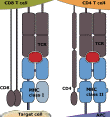Major histocompatibility antigens (MHC)The most important histocompatibility antigens are encoded by genes clustered in a genetic region defined as the Major Histocompatibility Complex (MHC). The human MHC or the Human Leukocytes Antigen (HLA) region comprises about 4MB on chromosome 6 encoding for approximately two hundred genes, many of which are involved in immune response. MHC genes in human encode for the HLA moleculesThe MHC contains two classes of HLA genes: HLA class I (HLA-A, HLA-B, HLA-C), which encode for the class I molecules and HLA class II (HLA-DR, HLA-DQ, HLA-DP), which encode for the class II molecules respectively. Some genes located between the class I and class II genes encode proteins of the complement system and are refered to as class III genes. Read more... Functions of MHC moleculesThe primary immunological function of Major Histocompatibility Complex (MHC) molecules is to bind and "present" antigenic peptides on the surfaces of cells for recognition (binding) by the antigen-specific T cell receptors (TCR's) of T cells. PolymorphismHLA genes are the most polymorphic genes in the human genome and as a consequence, very few individuals express the same alleles (MHC- or HLA-matched). According to the organ transplanted, results are better when the recipient and the donor are HLA-matched. To be able to do the best matching between the donor and the recipient, the MHC alleles are determined by HLA typing before the transplantation. Read more... Role of minor histocompatibility antigens (mHC)Read more... |
|
|
Transplantation Immunology | |||||||||||||||||||
|
||||||||||||||||||||




 Print
Print